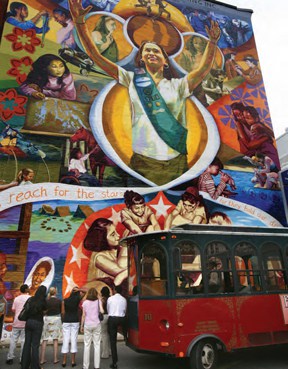A WALKING TOUR OF THE CITY’S ART AND GARDENS
STORY BY Martha Thomas
It might seem unpatriotic – if not downright heretical, especially in an election year – to suggest we forget Liberty for a while, that we relegate the Declaration of Independence and its worthy authors to the sidelines. On a recent trip to Philadelphia, instead of preambles, we enjoyed pleasant ambles, ignoring the Constitution in favor of a lovely constitutional.

And while our favorite place to stroll was named for one of the most notorious residents of the city, other than its name, the Benjamin Franklin Parkway has more to offer in the way of non-partisan plantings and paintings than exhortations on freedom.
Indeed, Philadelphia is bursting with art, from the unassailable Museum of Art to the civic murals, to its most recent luminary, the Barnes collection. And equally engaging are the city’s gardens: some the legacy of iconic families, others part of high-minded civic planners. Whatever the provenance, Philadelphia’s art and gardens combine to make the city a dreamy weekend getaway.
On a recent weekend we parked ourselves at a modest hotel off Rittenhouse Square – the Radisson Plaza Warwick Hotel – that turned out to be a perfect location for our weekend of walking.
We arrived late Friday afternoon and began the weekend with a stroll down the Benjamin Franklin with a clear destination: the Philadelphia Museum of Art. The august institution stays open late on Friday evenings, for Art after 5 – with music and drinks. While only the first floor galleries are available, it’s nice to stroll among the American collection, which includes, of course, plenty of works by the city’s beloved Thomas Eakins.

The artist’s “May Morning in the Park” – the painting set in Fairmont Park, adjacent to the museum – fit right in with the theme of our trip – mixing up visits to the city’s art collection with walks through its parks and gardens. The museum has several works by another native son, Daniel Garber, whose influence by the French Impressionists is apparent in the beautifully lit “The Orchard Window.” Mary Cassatt, who was born close to Pittsburgh, is also well represented here, with such familiar works as “Maternal Caress,” of a mother and child in, yes, a garden.
As we stepped out of the museum into a starry night, we looked across the grand parkway – the Benjamin Franklin is designed after the Champs Elysées in Paris – and the view reminded me how important such public spaces are to a city’s identity.
The thoroughfare was constructed in the 1920s, inspired by the City Beautiful movement, which was also behind the creation of the National Mall in Washington, D.C. One assumption was that beautiful urban spaces would somehow improve the character of city residents. While the notion has a whiff of noblesse oblige, there, nevertheless, may be some truth to it. A well planned city with grand public spaces seems to pay tribute to all its citizens in the way a bronze sculpture may honor only one.
The parkway cuts along a diagonal, joining the museum to City Hall (and the plaza known as Love Park, for the famous Robert Indiana sculpture there), and is lined with museums and civic buildings. In the past few years, the parkway has undergone about $17 million in renovations. The nearby Rodin Museum, with the largest collection of the sculptor’s works outside of Paris, has likewise had a facelift, with re-opening scheduled for late spring. One of the artist’s most famous sculptures, “The Thinker,” strikes his pensive pose at the museum’s entrance.

Photo by B. Krist for GPTMC
The biggest news in the Philadelphia art – and garden – scene, is the new home for the Barnes, the art collection amassed by Philadelphia-born Albert C. Barnes, a chemist who made his fortune by developing an antiseptic drug to treat gonorrhea. The Impressionist and Post-Impressionist paintings, American furniture, cultural art and artifacts and works by old masters, has been moved from a Philadelphia suburb to a new home on the Benjamin Franklin Parkway.
The limestone building – designed by the firm of Tod Williams and Billie Tsien – topped by a glass canopy to bring in natural light and outfitted with solar cells, will not only house the collection, but will honor another of Barnes’ passions: horticulture. The landscape design, by the firm Laurie Olin, includes classic French-style allées, grand London plane trees and a 70-foot black granite water feature, planted with water lilies – “forever related to the 19th century impressionists,” says Yue Li, project manager for the landscape design.
After visiting the museum, we sampled another type of gardening that Philadelphia is becoming increasingly known for. The farm-to-table restaurant scene is thriving, here, and we had a taste of homegrown cuisine at Pub and Kitchen, a gastro pub not far from our hotel. The food was delicious: kale salad with pears and dried cherries, baked cod with fennel and sundried tomatoes, local beer and cocktails made from herbs and honey.
The next morning, after a breakfast at the busy Reading Terminal Market, we embarked on our second art tour. This time, with a map and a cell phone, we went in search of murals. There are hundreds of public murals throughout the city, thanks to a program launched in 1984. We followed a prescribed walking tour that weaves through downtown. At each stop, we could dial a number on the phone and listen to a recorded description of the work, by the muralist or member of the community.
We finished the mural tour in the mid-afternoon and stopped at the Rittenhouse Hotel – across the square from our hotel – to rest our feet at the Mary Cassatt Tea Room. The elegant sunken living room, adjacent to a pretty enclosed garden, serves a full tea each afternoon, with scones and sandwiches. Be sure to make a reservation as the tea room – reminiscent of the artist’s soothing palette and pretty interiors – is also a popular place for bridal showers and other celebrations.
That evening, we walked to the World Café Live, across the river in the University City section of Philadelphia. Located in a renovated Art Deco factory building, the music venue has three stages and features the kind of contemporary musical acts that appear on the WXPN radio show of the same name. (This summer, look for Rhett Miller, Smash Palace and the Portland Cello Project.)
Early for the concert, we stopped in at the Tria Wine Room next door to the World Café, for a snack of artisanal cheeses, a salad with mission figs and house-made lamb sausage with white beans.
The next day, we had brunch at Garces Trading Company, a restaurant that we’d seen on the previous day’s mural tour. The owner, Jose Garces, was an Iron Chef contestant and a James Beard winner (for best chef in the mid-Atlantic) and has seven restaurants in the city. This one has a food shop that sells bread, cheese and pastries, and an adjacent wine cave where wines can be purchased to go with your meal.
After brunch, we packed up and drove to the Morris Arboretum in the Chestnut Hill neighborhood of Philadelphia. The Morris, now owned by the University of Pennsylvania, was once the summer home of brother and sister John and Lydia Morris, whose Quaker family had operated an iron manufacturing firm. The siblings were passionate about travel and horticulture and scoured the world in search of interesting trees and plants for their estate. While the original house no longer stands, the 92-acre arboretum has some wonderful features, like the Fernery, an eight-sided glass house packed with ferns, a Japanese garden, a swan pond and sculptures installed throughout. A recent installation is the family-friendly Tree Adventure with its high walkways in the trees, oversized nest with robin eggs and “squirrel scramble” – a rope netting high above the ground.
We could have spent the entire afternoon wandering the Morris, resting by the stream or in the serene Japanese garden, breathing in the rich scent of roses, or the humid air of the Fernery, reading the signs that described the trees and flowers from Europe and Asia, transplanted here so long ago by the intrepid patrons. But we had one more stop, Longwood Gardens.
Longwood is the highly polished and tourist-friendly former home of Pierre DuPont, of the eponymous chemical company (makers of Kevlar, Teflon and Corian). Its 1,000-plus acres include formal gardens modeled after the French palace of Versailles and beaux arts greenhouses filled with tropical plants, orchids and fountains. There are paved walkways and easy-to-read signage. It’s exceedingly well manicured, in contrast to the tangled romance of the Morris, and very popular. The parking lot was filled when we arrived, and you enter the vast gardens through a welcome center with a well stocked gift shop. Beginning June 9, Longwood will be extravagantly illuminated by British lighting designer Bruce Munro. His installation, Field of Light – glowing towers, cascading raindrops and carpets of delicate flowers – will be on display through the end of September.
In our short trip to Philadelphia, we barely scratched the loamy earth of its gardens, barely glimpsed its bounty of art. But we realized that a city known by so many busloads of school children for the Liberty Bell and Constitution Hall is known – and loved – by its residents for the grand gesture of the public space, the tree-lined boulevard and public fountain – as well as for its careful collections of all things beautiful, from a painting by Mary Cassatt to a delicate orchid carried carefully home by a gilded age adventurer.




